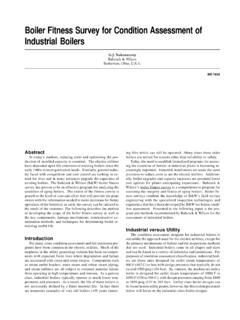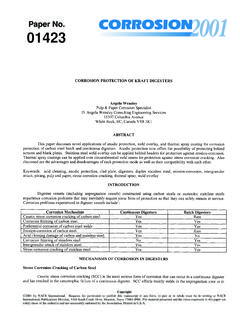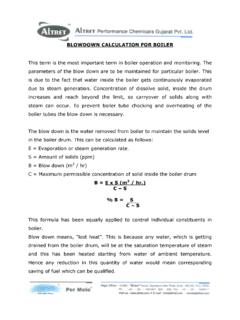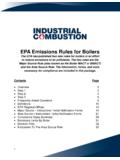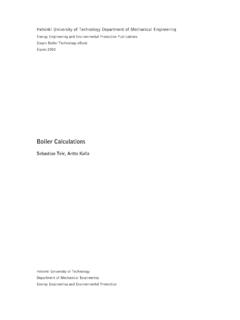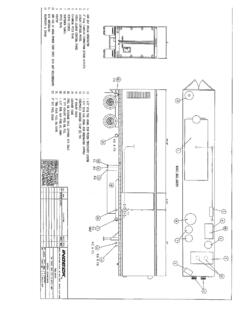Transcription of Barry Dooley The Current State of Boiler Tube …
1 PowerPlant Chemistry The Current State of Boiler Tube Failures in Fossil Plants Barry Dooley Peter S. Chang The Current State of Boiler Tube Failures in Fossil Plants INTRODUCTION Consolidation of utilities. Systems optimization to balance efficiency, capacity, emissions, and reliability in combining At the last international Boiler tube failure conference in utility markets. 1991 [1], the conference participants ranked the following areas as being of the highest priority to improve the overall Each or all of these trends is leading to less people in area of Boiler tube failures (BTF): plants and, in many cases, to those people previously in- volved in BTF moving to new responsibilities so any con- Understanding corrosion fatigue and developing tinuity is lost. solutions. Developing NDE techniques for corrosion fatigue. This amplifies one of the conclusions from the last con- Improvement in fly ash erosion control. ference that the barrier to achieving major availability im- Better identification of mechanisms.
2 Provements is not technical, but one of management and economics. It appears that in the Current market the adop- Management commitment. tion of formalized company-wide BTF Reduction Programs It was also noted that BTF ranked as the number one is now of paramount importance. This is discussed again equipment problem in fossil plants and had remained there later. for the previous 28 years [2]. However, the situation ap- peared to be improving: the equivalent unavailability factor Boiler TUBE failure DEMOGRAPHICS. due to BTF was about % and was decreasing on an annual basis (Figure 1). There have been a number of previous EPRI/NERC pro- grams to assess the statistics of BTF [2,4]; these together with the 1991 Conference Survey [1], and on-going as- sessments of the industry, provide a Current ranking of BTF. mechanisms (Table 1). In terms of Boiler locations, most comprehensive BTF data compilations worldwide indicate that the order of decreasing failures is waterwalls, superheater, reheater and econo- mizer.
3 Corrosion Fatigue Fly Ash Erosion Under Deposit Mechanisms (Hydrogen Damage and Acid Phosphate Corrosion). Long Term Overheating/Creep Figure 1: Equivalent Unavailability Factor Due to BTF: Short Term Overheating Boiler Tube failure Reduction Program Sootblower Erosion (BTFRP). Fireside Corrosion (Waterwall, Superheater, Reheater). Utilities are shown and compared with the National Average for Coal Fired Units greater Table 1: Leading BTF Mechanisms (in order of than 200 MW. (Data supplied by NERC/GADS) availability loss in MWh). Six years later it is disappointing to report that the situation Boiler TUBE failure MECHANISMS. in the industry has deteriorated, and that in 1996 the un- availability factor was at about % and increasing on an In the last six years enormous strides have been made in annual basis (Figure 1). addressing the top two mechanisms in Table 1. The third group of mechanisms relates to the importance of cycle Previous and subsequent analyses have indicated that the chemistry which has improved in parallel.
4 One area which is disturbing feature of these BTF is that most of them are not high on the list but which is currently of major concern in repeat failures. This is despite the major efforts expended the industry is that of waterwall fireside corrosion in units to understand the mechanisms and possible root causes, with low NOx burners. Each of these failure areas will be and to develop permanent solutions. A recent compilation briefly overviewed in this paper to represent the key tech- provides the theory and action oriented procedures for each nical developments over the last 6 years. Although it is very BTF mechanism [3]. important to identify the mechanism and root cause of each A number of possible reasons for this downturn can be failure to ensure low availability loss and to eliminate repeat suggested: failures, a large number of utilities often misdiagnose BTF. mechanisms [14]. Careful attention has been given over the Impending deregulation of the utility industry. last six years to assemble the tools that utilities need to Competition forces the utilities to be more cost sensitive.
5 Eliminate this [3]. An example is provided. This means less capital replacement projects. Plant per- sonnel perform more repair or partial replacement. PowerPlant Chemistry 2000, 2(4) 197. The Current State of Boiler Tube Failures in Fossil Plants PowerPlant Chemistry Corrosion Fatigue The influence of the Boiler water environment has similarly Corrosion fatigue has been the leading single cause of been confused in the years prior to the last conference, availability loss in fossil plants for over 20 years. However, basically because the initial laboratory studies clearly sug- work conducted in the last 5 years has started to provide gested that oxygen was important in increasing corrosion the tools to the industry for identifying and overcoming the fatigue [6,8]. However, detailed monitoring undertaken in failure mechanism. This work has also clarified the in- Canada, US and Australia [7,9] indicated that at the time fluence of stress and environment on the mechanism. An when the peak strain is imposed on the tubing, the dis- approach involving an Influence Diagram (Figure 2) in- solved oxygen in the Boiler water has usually decreased to tegrates the three basic influences: stress, environment and low levels (< 20 g/kg).
6 Further monitoring of a large num- operating history [3,5]; each will be briefly discussed here to ber of units operating with congruent phosphate treatment illustrate the latest thinking. [10,22] indicated that these units can suffer from phosphate hideout and return; conditions which can superimpose a pH. Operating hours and the number of unit starts are combined depression at the time of the peak strain. This recognition into an equivalent operating hours. It is also clear that the was followed by a second series of laboratory studies [11]. number of chemical cleans is also important. Figure 3 shows the effect of oxygen on corrosion fatigue crack initiation in Boiler tubing. Below about 135 C (275 F). there is very little effect of increasing oxygen levels, whereas above this temperature there is a marked de- pendence: N = 2445 DO (1). where N is the number of cycles to initiate cracks, and DO. is the dissolved oxygen ( g/kg). These results are very important in that they suggest that oxygen has very little effect on corrosion fatigue during the startup period when the peak strain on the tubing is highest.
7 PH was also shown to have a strong effect at constant low levels of dissolved oxygen (5 g/kg). Figure 4 shows that the number of cycles to initiation is reduced to about one third at both 204 C (400 F) and 274 C (525 F) when the pH level was approximately 6 as compared to the base condition of pH 9. Figure 2. Influence Diagram for Corrosion Fatigue in Waterwall tubes . Figure 4: The Influence of pH on Cycles to Initiation of Corrosion Fatigue Cracks in Deaerated Boiler Figure 3: The Influence of Dissolved Oxygen on the Water (< 5 g/kg oxygen). Cycles to Initiate Corrosion Fatigue Cracks in Boiler Water. The pH was controlled with phosphate solutions of different Na:PO4 molar ratios. The influence of stress can be provided qualitatively through a Stress Rank, A - D, in order of decreasing stress These recent monitoring and laboratory studies have im- for each of the 24 susceptible locations. However, it is now portant implications for corrosion fatigue in boilers, as the clear that corrosion fatigue is a discontinuous process in- recent results imply that cracks may only initiate, re-initiate volving the initial breakdown or fracture of the protective and/or grow when the environmental conditions are con- magnetite, and the repetitive breakdown (re-initiation) when ducive.
8 Inactive cracks are found in field studies indicating the critical fracture strain for magnetite is exceeded. The that the process is not continuous but consists of a series of German Technical Rules for Steam Boilers (TRD 301) have re-initiations at times when the strain on the inside tube stipulated for numerous years that the applied oxide strain surface is great enough to crack the magnetite (> %). levels should be less than % in tension. More recent It is clear that in the laboratory environment an increase in monitoring on a Boiler in Australia [9] which linked the re- dissolved oxygen levels from 5 to 1,000 g/kg will sig- sults from small gauge length strain gauges with finite ele- nificantly decrease the number of cycles to initiate corrosion ment analyses has indicated that the peak strains at cor- fatigue cracks at high temperatures (135 C or 275 F). rosion fatigue sites are greater than %. (Figure 3). There is also no doubt that during a shutdown 198 PowerPlant Chemistry 2000, 2(4).
9 PowerPlant Chemistry The Current State of Boiler Tube Failures in Fossil Plants period the oxygen level in Boiler water can reach high, per- eighth in the overall ranking of availability loss (Table 1). haps saturation, levels; but these periods do not generally The industry has been concerned about possible increased occur at the same time as the peak in applied strain level. levels of waterwall corrosion ever since low NOx burners Thus it is important to know both the time dependency of were first installed over 20 years ago. Many millions of dol- elevated oxygen levels and the peak strain. lars have been expended by utilities on ultrasonic thickness inspections of large areas of waterwalls without finding any This situation should be contrasted with that for pH de- increased levels of corrosion. pressions, where the pH of the Boiler water can be de- pressed during the period of peak strain at locations sus- ceptible to corrosion fatigue. Thus a detailed understanding of the major influences is not an easy process for each case of corrosion fatigue and re- quires a detailed field monitoring program (environment and strain).
10 Fly Ash Erosion In most countries, fly ash erosion (FAE) is the most serious or second cause of availability loss for fossil plants. His- torically the approach has been to arbitrarily position solid shields and baffles or apply a variety of coatings in areas'. where FAE was occurring. It was recognized in an earlier study that the use of these palliative repair techniques was the main cause of repeat failures due to fly ash erosion. They simply redirected the high velocity flow onto an ad- jacent tube area [3]. The rate and extent of erosive processes are affected by particle velocity, angle of impact, particle composition and shape, and erosive resistance of the tube surface including compositional and temperature variations. Particle velocity is the most important parameter as the rate of erosive loss is proportional to the velocity raised to an exponent that ranges between two and four. Particle ve- locity is driven by the local flow velocity at any particular Boiler location. The optimum long term solutions are based on identifying and reducing the highest velocity locations.
